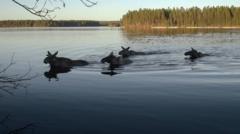Every year, millions join in the marvel of "The Great Moose Migration," a continuous livestream broadcast by Sweden's national broadcaster, SVT Play, which began its spring program earlier this season due to unseasonably warm weather. For six years, dedicated fans have tuned in to watch as elk swim across the Angerman River, embarking on their time-honored trek toward lush summer pastures.
This ritual has taken root as a cultural phenomenon, relying heavily on a growing community of viewers. Many, like 60-year-old Cait Borjesson, have found comfort in the streaming experience, which allows them to engage with the tranquil sounds of nature even from their homes. Borjesson, who has tuned into the stream for 16 straight hours, likens the experience to therapy, helping to ease her anxiety during a time when many have sought refuge in nature amidst the stress of modern life.
The audience for this unique broadcast has swelled over the years, reaching nine million viewers in 2024. This includes a vibrant Facebook group with over 77,000 members who share their thoughts, emotions, and favorite moments from the livestream.
Experts note that the migration is not merely an entertainment spectacle; it represents an essential ecological behavior that has persisted since the ice age. Goran Ericsson, an advisor for the broadcast and dean at the Swedish University of Agricultural Sciences, explained that nearly 95% of elk in northern Sweden partake in this yearly journey, slowly making their way back to summer ranges after wintering in warmer spots.
Capturing this journey are over 30 strategically placed cameras that provide a panoramic view of the elk's natural habitat. Research indicates a growing appreciation for this "slow TV" format, which emphasizes uninterrupted experiences of nature. Minh-Xuan Truong, a researcher at the same university, highlights that viewers often prefer the ambient sounds of the forest over musicals or narration, finding joy in the purity of the elk's migration and the untouched beauty of the Swedish woodlands, home to around 300,000 elk known famously as the "King of the Forest."























